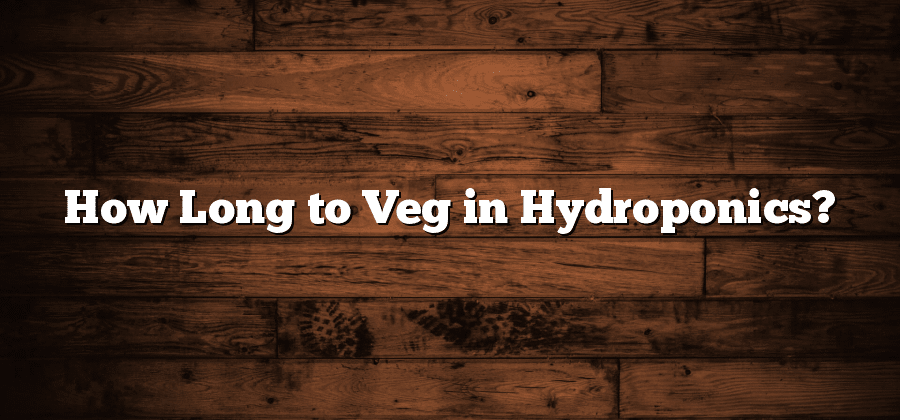Understanding the Vegetative Stage in Hydroponics
The vegetative stage in hydroponics is a crucial stage of plant growth where the focus is on building strong and healthy plants. This stage is characterized by rapid leaf and stem development, as the plants collect energy from light to create an abundance of chlorophyll. During this phase, plants do not produce flowers or fruits, but rather focus on establishing a strong foundation for future growth.
One of the key factors that affect the vegetative time in hydroponics is the genetics of the plant. Different plant varieties have varying growth rates and durations of the vegetative stage. Factors such as nutrient availability, temperature, and lighting can also influence the duration of the vegetative phase. It is important for hydroponic growers to understand and optimize these factors to ensure healthy plant growth and maximize yields in their systems.
Factors Affecting Vegetation Time in Hydroponics
Factors affecting vegetation time in hydroponics can vary depending on several key elements. One of the primary factors is the choice of plant species. Different plants have different growth rates and developmental needs, which can impact the duration of the vegetative stage. For example, fast-growing plants like lettuce may have a shorter vegetative phase compared to slower-growing plants like tomatoes.
Another factor that can influence vegetation time is the quality of the growing environment. Factors such as temperature, humidity, and airflow play crucial roles in plant growth and development. Optimal environmental conditions can promote healthier and more vigorous growth, leading to a shorter vegetative phase. On the other hand, unfavorable conditions can slow down growth and extend the duration of the vegetative stage. It is essential for hydroponic growers to monitor and control these environmental factors to ensure optimal vegetation time.
Optimal Light Duration for Vegetation in Hydroponics
Light is a crucial element for the growth and development of plants in hydroponics. During the vegetative stage, providing the optimal light duration is essential to ensure healthy and robust plant growth. The duration of light exposure for vegetation in hydroponics is typically between 14 to 18 hours per day.
When determining the optimal light duration, it is important to consider the type of plant being grown and its specific light requirements. Some plants may thrive with slightly shorter or longer light durations, so it is essential to research the specific needs of the plant species you are cultivating. Additionally, it is crucial to consider the intensity of the light provided, as this can also impact the optimal duration. By carefully monitoring and adjusting the light duration based on the plant’s needs, growers can maximize photosynthesis and promote vigorous vegetative growth in their hydroponic systems.
Nutrient Requirements during the Vegetative Stage
During the vegetative stage in hydroponics, providing the right nutrients to your plants is essential for their healthy growth and development. This stage is characterized by rapid leaf and stem growth, which requires an adequate supply of macro and micronutrients. Nitrogen, phosphorus, and potassium are the primary macronutrients needed in higher quantities during this stage. Nitrogen promotes leaf and stem growth, phosphorus assists in root development, and potassium aids in overall plant vigor and disease resistance. These nutrients can be provided through commercially available hydroponic nutrient solutions, which are formulated specifically to meet the needs of plants in the vegetative stage.
In addition to the primary macronutrients, plants also require a range of micronutrients for proper functioning. These include calcium, magnesium, iron, manganese, zinc, copper, and boron, among others. Although required in smaller quantities, these micronutrients are equally important for overall plant health. A deficiency in any of these micronutrients can lead to reduced growth, nutrient imbalances, and susceptibility to pests and diseases. Therefore, it is crucial to ensure that these micronutrients are included in the nutrient solution or supplemented separately, if necessary. Regularly monitoring the nutrient levels in the hydroponic system and making necessary adjustments will help maintain optimal nutrient availability for your plants during the vegetative stage.
Pruning and Training Techniques in Hydroponic Vegetation
Pruning and training techniques are essential for optimizing plant growth and maximizing yields in hydroponic vegetation. Through strategic removal of certain plant parts and the implementation of physical support systems, growers can shape and direct the growth of their plants.
One common technique is known as “topping,” which involves the removal of the apical meristem – the growing tip – of the plant. This encourages lateral branching and allows for a more bushy and compact plant shape. By removing the top bud, the plant’s energy is distributed to the lower branches, resulting in increased overall growth. Similarly, “pinching” can be used to remove the growing tip of specific lateral branches, diverting energy to the development of other branches. These techniques are particularly useful for controlling plant height and promoting a more balanced canopy.
Another technique commonly used in hydroponics is plant training, specifically through the use of trellises or stakes. By providing support to the growing stems and branches, these systems help maintain an organized and upright plant structure. This is especially beneficial for crops with heavy fruiting, preventing branches from collapsing under the weight. Properly trained and supported plants also have increased access to light and air, leading to improved photosynthesis and overall plant health. These techniques are essential for creating a productive and efficient hydroponic system.






